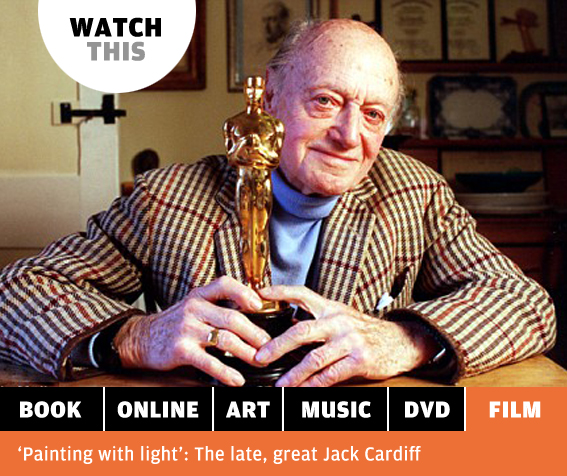A few years ago I was fortunate enough to be in the audience for a special screening of Powell and Pressburger’s A Matter Of Life And Death (1946) introduced with a talk by the late, great cinematographer Jack Cardiff. Jack was in his late 80s then but the spectrum of colours that he mastered during in his career still twinkled in his eyes. Craig McCall’s new documentary Cameraman celebrates Cardiff’s life and work.
Cameraman was screened out of competition at Cannes this year, just a little over a year after Cardiff’s death at 94. To quote from the film’s press junket: the film illuminates a man whose life and career are inextricably interwoven with the history of cinema. The phrase ‘legend’ is all too frequently used in Hollywood, yet Jack Cardiff’s story surely proves him truly worthy of that title.
On 25th March 2001, 54 years after winning his first Oscar® for his stunning Technicolor cinematography on Black Narcissus (Powell & Pressburger 1947), Cardiff was the first cinematographer ever presented with an Honorary Oscar® for ‘exceptional distinction in lifetime achievement; exceptional contributions to the state of motion picture arts and sciences; and for outstanding services to the Academy.’
Throughout the documentary, the master himself explains how he helped elevate cinematography to an art form and made history with his groundbreaking vision and technical wizardry in films such as A Matter Of Life And Death, The Red Shoes (Powell & Pressburger 1948), The African Queen (John Huston 1951), The Vikings (Richard Fleischer 1958) and many others.
Amongst many fascinating revelations and anecdotes in the film, Jack relates what it was like to work with Hollywood’s greatest icons: Marilyn Monroe, Audrey Hepburn, Humphrey Bogart, Kirk Douglas and Sophia Loren. Martin Scorsese discusses Jack’s films and tells us why they have had such an influence on him. ‘I began to have a very strong affinity towards British Cinema, because of my recognition of Jack Cardiff’s name.’
Cameraman contains many clips from classic movies and over twenty original interviews with the world’s greatest actors, directors and technicians. It explores Jack’s life and work in compelling detail, scope and intimacy. The film is not only a unique and valuable testimony to British and international cinema history; it’s a humorous and informative one too – an amazing story about an exceptional life.
One can only hope that Cameraman secures at least a limited commercial release schedule beyond Cannes and the host of screenings running at the NFT throughout May, to give as many people as possible a chance to see Cardiff’s work on the big screen. If you can’t wait for it to come your way I can heartily recommend his warm and wonderful autobiography Magic Hour (Faber & Faber 1997).
Among many lovely anecdotes he writes of his time spent working on Albert Lewin’s Pandora And The Flying Dutchman (1951), the centerpiece film of issue 8 of The Big Picture, back in cinemas from 14th May. There are reminiscences about Ava Gardner and her spellbinding power over men, rather like the character of Pandora:
‘[The bullfighter] Mario Cabre was crazy about Ava. He wrote poems about her in Spanish and would read them to her with much fervour. But Mario wasn’t her only worshipper. [The director] Al Lewin was so entranced by her beauty that he would shoot many more close-ups than he needed, gazing at her as if in a trance.’
Cardiff was truly one of the greats; his sense of colour, derived from his great interest in paintings, continues to provide a palate for the imagination whenever one of the films he worked on is viewed. Catch Cameraman if you can.
Jez Conolly

